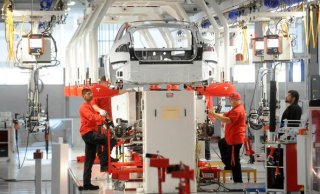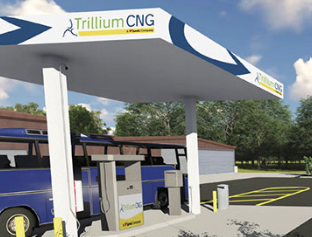Tesla yesterday reported a $675.4 million net loss, or $4.01 per share, in the fourth quarter as the automaker continued to invest in ramping up production for the Model 3. The net loss widened from  $619.4 million, or $3.70 per share, in the previous quarter but it was smaller than analysts had expected. Revenue was higher than expected at $3.29 billion in Q4, a nearly 10% increase from Q3 of last year. The company is taking a positive outlook for 2018, with the planned ramp of both the Model 3 and its energy storage products that should drive a revenue growth rate much higher than last year’s rate. The company’s cash balance remained stable last quarter even with the Model 3 production increasing, and not at the level originally planned by Tesla. CEO Elon Musk has been able to alleviate concerns that more cash will need to be raised soon. Customers are supporting efforts by putting down more than $850 million in deposits for its vehicles including the Semi truck and revised Roadster that Musk revealed in November. Timing of the SpaceX launch has helped, with the Musk’s Roadster being packed into the world’s most powerful rocket, the Falcon Heavy. “If we can send a Roadster to the asteroid belt, we can probably solve Model 3 production,” Musk said during the conference call with analysts yesterday.
$619.4 million, or $3.70 per share, in the previous quarter but it was smaller than analysts had expected. Revenue was higher than expected at $3.29 billion in Q4, a nearly 10% increase from Q3 of last year. The company is taking a positive outlook for 2018, with the planned ramp of both the Model 3 and its energy storage products that should drive a revenue growth rate much higher than last year’s rate. The company’s cash balance remained stable last quarter even with the Model 3 production increasing, and not at the level originally planned by Tesla. CEO Elon Musk has been able to alleviate concerns that more cash will need to be raised soon. Customers are supporting efforts by putting down more than $850 million in deposits for its vehicles including the Semi truck and revised Roadster that Musk revealed in November. Timing of the SpaceX launch has helped, with the Musk’s Roadster being packed into the world’s most powerful rocket, the Falcon Heavy. “If we can send a Roadster to the asteroid belt, we can probably solve Model 3 production,” Musk said during the conference call with analysts yesterday.
Porsche will be doubling its spend on vehicle electrification to more than 6 billion euros ($7.4 billion) by 2022, CEO Oliver Blume said in a statement. Half will go to material assets and the other half to development costs. About 500 million euros will develop variants of the Mission E all-electric sports car that will debut next year. The Mission E is expected to be rolled out with a few performance versions. The company will also will invest 1 billion euros for the electrification of its existing products. Porsche has been placed to that a plug-in hybrid version of the Panamera sedan as it top version with longer electric range has been a success. About 60% of the new Panameras sold in Europe were equipped the hybrid powertrain, Porsche said.
Trillium CNG will be expanding its services, adding the design, building, and maintenance of hydrogen fueling stations. New services will also include electric vehicle charging infrastructure, solar panel installation,  and microgram design and construction. The first hydrogen station will supply fuel cell buses starting this summer for the Orange County Transportation Authority’s (OCTA) Santa Ana, Calif., facility. Transit buses will be able to tap into 35 kilograms of hydrogen per bus in 6 to 10 minutes simultaneously from two fueling lanes. The station will be able to fuel the current 10 fuel cell buses and can go up to 50 buses. Infrastructure will be added to OCTA’s existing CNG fueling lanes. The current CNG station was designed and built by Trillium CNG in 2007 and continues being maintained by the company. Air Products & Chemicals, Inc., will supply and deliver liquid hydrogen. The Center for Transportation and the Environment (CTE) a nonprofit that advocates for clean, sustainable, innovative transportation and energy technologies, is managing the project. CTE secured funds for the project from the California Air Resources Board through the California Climate Investments program, a statewide program that puts billions of cap-and-trade dollars to work reducing greenhouse gas emissions, strengthening the economy, and improving public health and the environment.
and microgram design and construction. The first hydrogen station will supply fuel cell buses starting this summer for the Orange County Transportation Authority’s (OCTA) Santa Ana, Calif., facility. Transit buses will be able to tap into 35 kilograms of hydrogen per bus in 6 to 10 minutes simultaneously from two fueling lanes. The station will be able to fuel the current 10 fuel cell buses and can go up to 50 buses. Infrastructure will be added to OCTA’s existing CNG fueling lanes. The current CNG station was designed and built by Trillium CNG in 2007 and continues being maintained by the company. Air Products & Chemicals, Inc., will supply and deliver liquid hydrogen. The Center for Transportation and the Environment (CTE) a nonprofit that advocates for clean, sustainable, innovative transportation and energy technologies, is managing the project. CTE secured funds for the project from the California Air Resources Board through the California Climate Investments program, a statewide program that puts billions of cap-and-trade dollars to work reducing greenhouse gas emissions, strengthening the economy, and improving public health and the environment.



